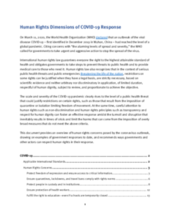On March 11, 2020, the World Health Organization (WHO) declared that an outbreak of the viral disease COVID-19 – first identified in December 2019 in Wuhan, China – had reached the level of a global pandemic. Citing concerns with “the alarming levels of spread and severity,” the WHO called for governments to take urgent and aggressive action to stop the spread of the virus.
International human rights law guarantees everyone the right to the highest attainable standard of health and obligates governments to take steps to prevent threats to public health and to provide medical care to those who need it. Human rights law also recognizes that in the context of serious public health threats and public emergencies threatening the life of the nation, restrictions on some rights can be justified when they have a legal basis, are strictly necessary, based on scientific evidence and neither arbitrary nor discriminatory in application, of limited duration, respectful of human dignity, subject to review, and proportionate to achieve the objective.
The scale and severity of the COVID-19 pandemic clearly rises to the level of a public health threat that could justify restrictions on certain rights, such as those that result from the imposition of quarantine or isolation limiting freedom of movement. At the same time, careful attention to human rights such as non-discrimination and human rights principles such as transparency and respect for human dignity can foster an effective response amidst the turmoil and disruption that inevitably results in times of crisis and limit the harms that can come from the imposition of overly broad measures that do not meet the above criteria.
This document provides an overview of human rights concerns posed by the coronavirus outbreak, drawing on examples of government responses to date, and recommends ways governments and other actors can respect human rights in their response. It includes chapters on protecting people in custody and institutions, fulfilling the right to education, and addressing the disproportionate impact on women and girls.

